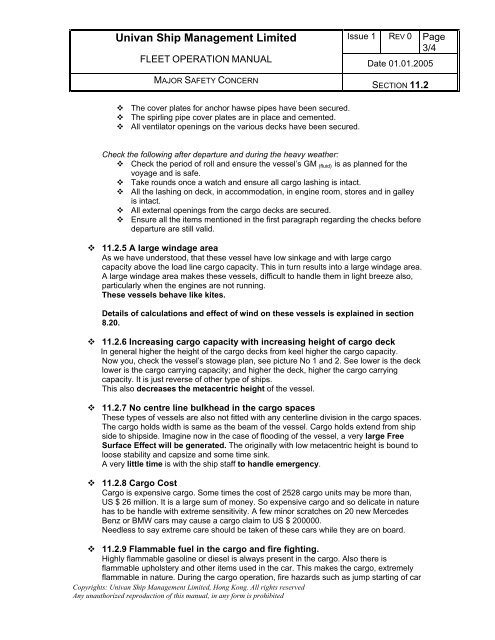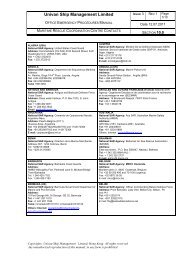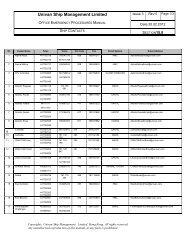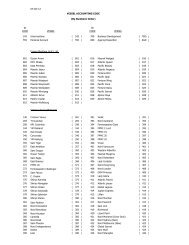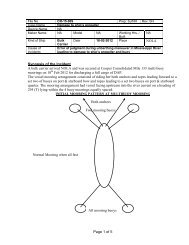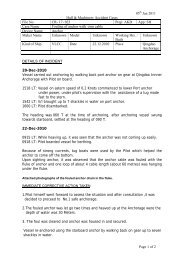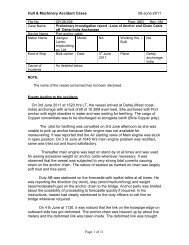Section: 11 CARGO OPERATIONS - Univan
Section: 11 CARGO OPERATIONS - Univan
Section: 11 CARGO OPERATIONS - Univan
You also want an ePaper? Increase the reach of your titles
YUMPU automatically turns print PDFs into web optimized ePapers that Google loves.
<strong>Univan</strong> Ship Management Limited Issue 1 REV 0 Page<br />
3/4<br />
FLEET OPERATION MANUAL Date 01.01.2005<br />
MAJOR SAFETY CONCERN<br />
The cover plates for anchor hawse pipes have been secured.<br />
The spirling pipe cover plates are in place and cemented.<br />
All ventilator openings on the various decks have been secured.<br />
SECTION <strong>11</strong>.2<br />
Check the following after departure and during the heavy weather:<br />
Check the period of roll and ensure the vessel’s GM (fluid) is as planned for the<br />
voyage and is safe.<br />
Take rounds once a watch and ensure all cargo lashing is intact.<br />
All the lashing on deck, in accommodation, in engine room, stores and in galley<br />
is intact.<br />
All external openings from the cargo decks are secured.<br />
Ensure all the items mentioned in the first paragraph regarding the checks before<br />
departure are still valid.<br />
<strong>11</strong>.2.5 A large windage area<br />
As we have understood, that these vessel have low sinkage and with large cargo<br />
capacity above the load line cargo capacity. This in turn results into a large windage area.<br />
A large windage area makes these vessels, difficult to handle them in light breeze also,<br />
particularly when the engines are not running.<br />
These vessels behave like kites.<br />
Details of calculations and effect of wind on these vessels is explained in section<br />
8.20.<br />
<strong>11</strong>.2.6 Increasing cargo capacity with increasing height of cargo deck<br />
In general higher the height of the cargo decks from keel higher the cargo capacity.<br />
Now you, check the vessel’s stowage plan, see picture No 1 and 2. See lower is the deck<br />
lower is the cargo carrying capacity; and higher the deck, higher the cargo carrying<br />
capacity. It is just reverse of other type of ships.<br />
This also decreases the metacentric height of the vessel.<br />
<strong>11</strong>.2.7 No centre line bulkhead in the cargo spaces<br />
These types of vessels are also not fitted with any centerline division in the cargo spaces.<br />
The cargo holds width is same as the beam of the vessel. Cargo holds extend from ship<br />
side to shipside. Imagine now in the case of flooding of the vessel, a very large Free<br />
Surface Effect will be generated. The originally with low metacentric height is bound to<br />
loose stability and capsize and some time sink.<br />
A very little time is with the ship staff to handle emergency.<br />
<strong>11</strong>.2.8 Cargo Cost<br />
Cargo is expensive cargo. Some times the cost of 2528 cargo units may be more than,<br />
US $ 26 million. It is a large sum of money. So expensive cargo and so delicate in nature<br />
has to be handle with extreme sensitivity. A few minor scratches on 20 new Mercedes<br />
Benz or BMW cars may cause a cargo claim to US $ 200000.<br />
Needless to say extreme care should be taken of these cars while they are on board.<br />
<strong>11</strong>.2.9 Flammable fuel in the cargo and fire fighting.<br />
Highly flammable gasoline or diesel is always present in the cargo. Also there is<br />
flammable upholstery and other items used in the car. This makes the cargo, extremely<br />
flammable in nature. During the cargo operation, fire hazards such as jump starting of car<br />
Copyrights: <strong>Univan</strong> Ship Management Limited, Hong Kong. All rights reserved<br />
Any unauthorized reproduction of this manual, in any form is prohibited


